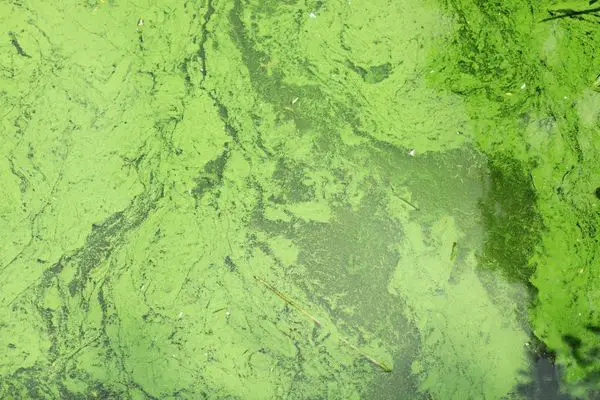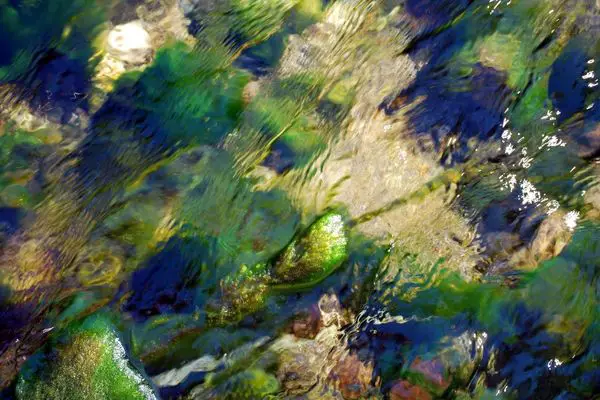So you turned up to your favorite lake, expecting clear water and a relaxing day on the water. What you discovered was a putrid green soup, with small chunks of slime bobbing around and a nice green slick on the surface.
Algae blooms are not the prettiest things to look, and at times they can smell quite bad. But, is it still possible to go fishing during a bloom? Are the trout still feeding, where do they actually go?
In this article, I will discuss my experiences of trout fishing during algae blooms.
Should you fish during an Algae bloom?
In most cases, it is advised to avoid fishing during algae blooms. This is because exposure to many algae species can cause various health issues and some algae can even produce toxins.
If you do decide to fish, it is advised to try and minimize all contact with the water, and certainly do not drink any of it. The Oregon Health Authority for example advises to “avoid direct skin contact” “wear protective gloves”, and “wash skin thoroughly with clean water” after finishing fishing.
Is it safe to eat fish caught during algae blooms?
I personally do not eat fish caught during a bloom, but the Oregon Health Authority claims “There have been no reports of people becoming sick from eating fish caught during a bloom, but there has been no definitive research regarding the risk to human health”
Generally speaking, migratory fish such as salmon and steelhead are considered safer to eat, then resident fish. That is because they spend less time in the river, so are likely to have lower levels of toxins in their bodies.
What causes algae bloom?
Algae blooms are usually caused by a combination of warmer water temperatures and high levels of nutrients. Such conditions allow algae to grow exponentially. Fertilizer and efflurent runoff and leaching is one of the major causes of blooms in many lakes.
With that said, there are some algae that can thrive in cold, relatively low-fertility water.
How deep do algae blooms go?
Algae blooms are generally thickest near the surface, with the majority of the bloom occurring in the top 10 meters (32 feet) of the water column. That is because this area receives the most sunlight, but giving the correct conditions algae can grow as deep as 90m (320ft) below the surface.
With that said, the thicker the bloom becomes near the surface, the more sunlight is absorbed depriving the deeper living algae of light which forces them to move towards the surface causing an even thicker layer of algae to form.
Overview of common types of algae blooms
Trout fishing during blue green algae blooms

The presence of green blue algae is a good indication that the trout fishing is going to be slow, this is because blue-green algae typically only blooms once the water is already too warm for trout.
Blue green algae is a microscopic plant that creates the majority of algae blooms, each individual algae is very tiny and if you try and pick them up they will just flow away with the water.
If you see blue green algae blooming chances are water temperatures, at least near the surface, will be exceeding 75F. Such warm temperatures, typically mean the trout will be long gone or seeking cooler temperatures much lower in the water column.
While it is possible to catch warm water species of fish during such a bloom, it is not usually recommended and many health departments advise avoiding contact with Blue-Green algae. This is because some species of blooming algae can produce toxins, and exposure to any blue-green algae blooms can cause a range of health issues.
If for whatever reason, you still want to trout fishing, then any trout still in the lake will likely be holding very deep among the themocline. The depth of the thermocline really depends on the lake.
Didymo and river slimes
Didymo use to fly under the radar, and never really caused many problems, but starting sometimes in the 1980’s it started to bloom and is now becoming an increasing problem in trout fisheries especially outside of its natural range.
Didymo, while harmless to humans, has the potential to ruin a days trout fishing, because it loves to grow in clear, pristine, cold water. Perfect trout habitat.
So what causes Didymo to bloom, and ruin a day’s fishing? Well, normally because the water is too clean.
According to research by NIWA NZ, Didymo normally only blooms, and becomes a problem when phosphorus is below two parts per billion, and when light intensity is high.
During Didymo bloom, every cast can come back covered in rock snot, it is just an endless nuisance to deal with.
In my experience, the best way to deal with Didymo blooming in the river is to stick with surface presentation, when fly fishing that typically means dry flies. Fishing with spinners or lures, becomes much harder. With every cast often becoming covered by slime.
I personally will disinfect my gear, and find a lake to fish instead, and would not return to the river until higher flows manages to flush the toilet.
Filamentous green algae

This is a common green slime that grows in many bodies of water. Unless it is growing in huge mats it is not that large of a concern. It usually grows on the bottom of rivers and lakes and can form large mats and long strains.
It is possible to pull large handfuls out of the water, and it clings and wraps itself around the fishing line.
This type of algae, a bit like Didymo is a pain to fish through but is not usually that damaging to the aquatic life in the area.
Can algae bloom kills fish?
Most algae blooms are not toxic, but the ones that are can quickly prove lethal to aquatic life. I remember observing an algae bloom forming once on a lake stocked with salmon, within days of the bloom appearing all the salmon were dead on the surface. A couple of weeks later, all the brown trout that were in the lake also disappeared.
Now, I can not say for sure whether it was the water temperature or the algae itself that killed the fish, but the algae certainly did not help.
I also do a lot of kayaking, when kayaking through blooms, it is not uncommon to see dozens of fish of all species dead on the surface. I once even saw a nice, large dead chinook salmon. I was paddling in a river fairly close to the ocean, so I suspect it died shortly after entering the river. Such a waste.
What can be done to prevent algae blooms?
Preventing algae blooms is easier said than done and usually requires the community as a whole to take action. The main causes are often outside the influence of any one person.
But as fishermen, there are a few things we can do, and the first is to avoid using chum in stagnant or still water. One person chumming might not cause a problem, but if hundreds are doing it every week can quickly increase the nutrient loading of any pond with poor circulations.
